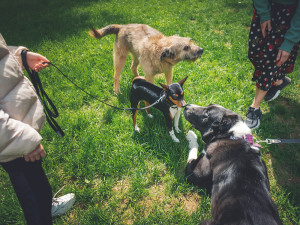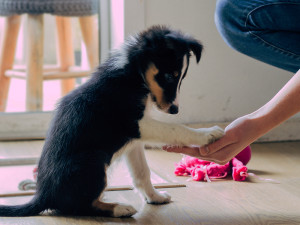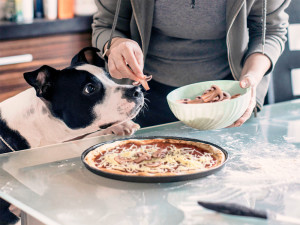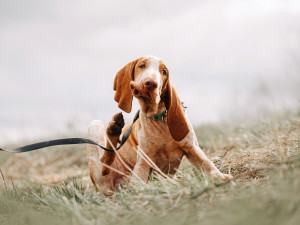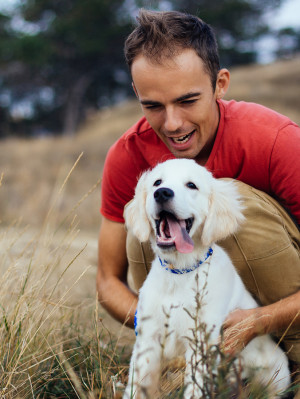How to Tackle Common ‘Pandemic Puppy’ Issues
Turns out, humans weren’t the only ones affected
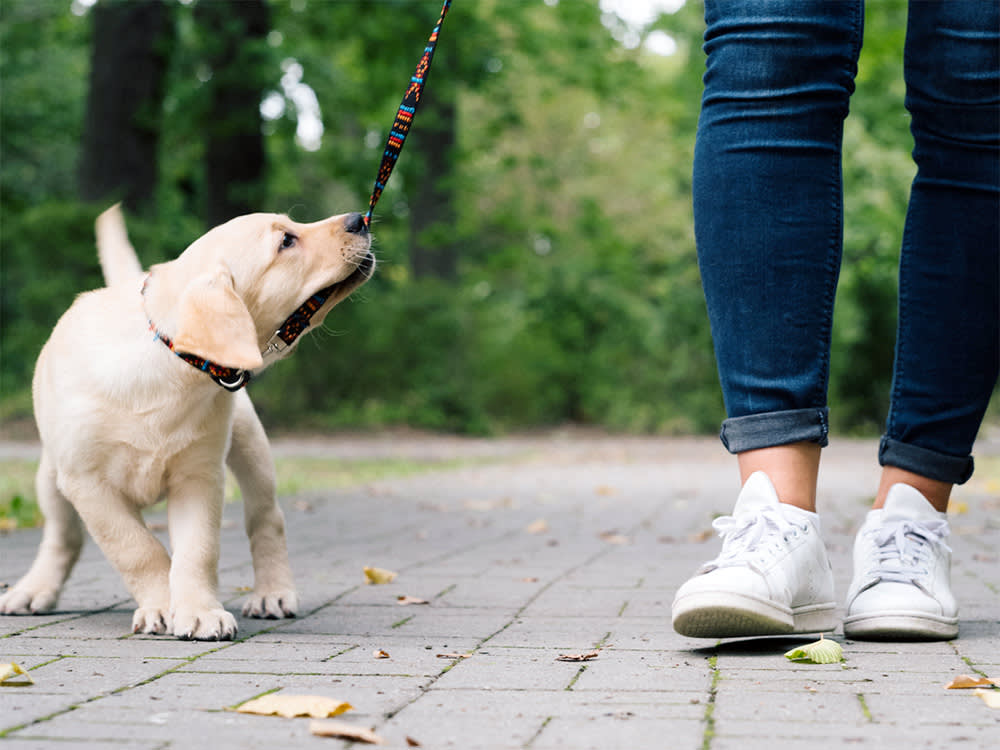
share article
As the world grappled with the challenges of the Covid-19 pandemic, many of us turned to the companionship of four-legged friends to alleviate the lockdown blues. However, as the transition to a new normal continued (continues?) in the years since the global pandemic, some pet parents are now finding themselves facing unexpected challenges with their newfound furry family members.
A recent study conducted by the Royal Veterinary College (RVC)opens in a new tab revealed that pet parents are encountering a number of behavioural issues with their ‘pandemic puppies’. 96.7 percent of pet parents who responded to the study reported their dog had at least one problem behaviour, including exhibiting issues such as separation anxiety and difficulties with socialisation.
These adorable bundles of joy that brought warmth and comfort into our homes during uncertain times are now having trouble adjusting to other environments outside the safety of home, with the most common behavioural issues materialising in pulling on the lead (67 percent), jumping up at people (57 percent) and not coming back when called (52 percent).
Other behavioural issues commonplace in the study, funded by Batterseaopens in a new tab, include chasing – eg, cats, wildlife, traffic – (35 percent) and barking or howling (33 percent). These challenges can be daunting. But fear not, dear pet parents, for there are strategies to address these issues and help your pup thrive. We discuss the common naughty behaviours with the experts and decode what you can do to improve your pandemic pup’s behaviour, and your relationship.
Why are pandemic puppies more susceptible to behavioural issues?
“It’s not surprising to see so many behavioural issues in pandemic puppies,” says veterinary surgeon Adam Brown MRCVS. “The sudden increase in pet parent presence during lockdown has resulted in heightened attachment and dependency, leading to separation anxiety when pet parents returned to work and school.”
Dr Ben Brilot, associate head of animal and agriculture at Hartpury University, echoes the sentiment, highlighting the impact of the pandemic on puppies’ social and environmental experiences. “There are many issues that have been caused by the lack of socialisation experienced by puppies that were bought [or adopted] and raised during the unusual circumstances of the Covid pandemic,” he says.
“Restricted social opportunities during lockdown also played their part,” added Brown, “creating a lack of exposure to various stimuli and ultimately causing difficulties in socialising with other dogs and people.”
But it’s not just missing out on key puppy socialisation experiences and environmental factors that have contributed to an increase in poor behaviour from these pandemic pups. The RVC study also found that pandemic puppies bought or adopted during the Covid-19 pandemic were exposed to a number of other early-life risk factors for problem behaviours, including being more likely to be bought by first-time owners and more likely to be bought from poor welfare sources.
According to the study, 33 percent of overall respondents thought training their dog was harder than expected, something that was even more likely for first-time pet parents, and 15 percent thought their dog’s behaviour was worse than they expected before they brought the pup home. Parents of large dogs (>40kg) were also more likely to think their dog’s behaviour was worse than they expected, according to the RVC’S findings.
The reality is, dogs of all shapes and sizes are complex animals and need “extensive, lifelong training to fit within our human lives and expectations” says the report. Ensuring you are well-prepared, have realistic expectations and are able to meet the training needs of your new family member are key when considering taking on a puppy or dog of any age.
What can you do to tackle common pandemic puppy behavioural issues?
For some pet parents, tackling these naughty tendencies might seem like an insurmountable challenge, but there are a number of “potentially straightforward things that owners can do to help their dogs,” says Dr Brilot. Controlled socialisation experiences, positive reinforcement and gradual exposure to new stimuli are key in helping pandemic puppies become confident and well-adjusted dogs.
Dr Brilot emphasises the importance of not just regular exercise, but also engagement for your pup’s well-being. “Engagement doesn’t have to be limited to walks; playing with toys or engaging in scent work at home can provide mental stimulation,” he says. By incorporating these activities into your pup’s routine, you can help alleviate any anxiety they may experience before venturing outdoors.
When it comes to socialising your furry companion, Dr Brilot recommends a gentle approach. “Choose quiet places with minimal distractions and introduce your pup to new stimuli gradually,” he suggests. Bringing along treats or toys can reinforce calm behaviour, but it’s crucial for pet parents to remain neutral in these situations. “Your pup should always have the option to remove themselves if they feel uncomfortable,” Dr Brilot adds.
While pandemic puppies may present behavioural challenges, with the right approach and support, these issues can be corrected. Prioritise regular exercise, provide mental stimulation, take a gentle approach to socialisation, and follow our expert guidance to tackling the top behavioural issues. As always, if you notice any concerning behavioural signs, don’t hesitate to seek professional help. Accredited trainers or clinical animal behaviourists can provide invaluable guidance on processes and help address any issues your pup may be facing.
How to stop your dog pulling on the lead
If walking on the leadopens in a new tab is something your pandemic pup is struggling with, then starting at home is half of the battle. You want them to be calm before you’ve even left the house so that you’re starting with a calm and collected dog. Then, practise walking with a loose lead in quieter places, or at quieter times.
“Your dog needs to clearly understand the position they are supposed to be in as they need simple, clear information that they can understand in any environment,” adds Gayle Lucyopens in a new tab, a dog behaviourist, trainer and founder of K9 Coach UKopens in a new tab. “All you need is a collar and lead: keep a fixed-length lead (not a bungee or flexi lead) and hold your hand against your body. If your hand moves out from your body, it means your dog has pulled on the lead and moved out of position.”
“Make sure you are training on your normal walks – not just in deliberate training sessions or in the garden,” adds Gayle. “Walking calmly to heel should be a normal part of life, not a directed exercise like a party trick. Timing, repetition and reinforcement are key to building a strong habit of walking alongside you.”
How to stop your dog from jumping up at people
Much like training your dog to walk in a loose-lead heel, stopping your dog from jumping upopens in a new tab starts at home. The act of jumping up at people is a lack of self control in your pup, so starting on some willpower exercises at home. Gayle recommends using your dog’s daily food allowance as positive reinforcement in their training, too, which you can use for some ‘place’ and ‘stay’ trainingopens in a new tab at home.
If your pup is jumping up at people as a reaction to fear or aggression, working on their socialisation (slowly, of course) and guiding them on loose-lead walks will help towards curbing those reactions overall, and then you will be able to tackle the jumping. If you’re out on a walk with your dog and they try to jump up at someone, turn 180 degrees into them so you’re standing the opposite direction, and walk them away from the scene of the crime. This stops the behaviour in its tracks and replaces it with another task (heeling).
How to stop your dog from running away off lead
Being off lead is a privilege. If your dog isn’t already coming 100 percent of the time when called off the lead, your dog isn’t ready to be let off the lead. Make sure you’re setting yourself up for success, and start recall training your dogopens in a new tab when you have a better chance of winning. For example, in your garden, or an enclosed space with less KFC chicken bones and squirrels than the local park.
Using a long-line (or a flexi-lead) can also help to reinforce your dog’s recall with a physical reminder of the direction they should be going in with a gentle tug (plus, stepping on the line if they don’t return saves you that internal panic). Practise, practise, practise, and start officially letting them off the lead in more controllable circumstances, eg, early mornings or late evenings when there are less dogs around.
Avoid aversive training measures
Four out of five participants (82.3 percent) in the RVC study disclosed their use of aversive training techniques (those that ‘punish’ dogs such as shouting) which vets cautioned could heighten fear and anxiety. Dr Rowena Packer, one of the authors of the RVC study, emphasised that while these actions might frustrate owners, “they are often a sign a dog is struggling to cope or that they haven't been taught an appropriate response in a situation, rather than dogs intentionally behaving ‘badly’.”
The study found that the most prevalent aversive methods included moving the dog or shouting at them, with some owners also resorting to tools like rattle bottles, water pistols and choke chains. Only 18 percent of surveyed owners refrained from using any aversive training methods or tools.
Dr Packer warned owners struggling with problem behaviour – combined with the cost of living crisis – could lead to them “reaching the end of their tether” and rehoming their dogs. In addition to the problematic behaviour recorded, some new pet parents struggled to know what behaviour was normal for dogs, she added, and, in many cases, were “potentially being exacerbated by owners using punishment-based training techniques”.
Robert Bays, Battersea’sopens in a new tab senior animal behaviour manager, said they were “deeply concerned” by the study’s findings, as the problem behaviour is potentially being worsened by owners resorting to aversive training methods.
“Without the right kind of positive training and support, a small behaviour problem in a puppy or dog can quickly escalate into a serious issue.” He cautioned that this approach could exacerbate behavioural problems in adulthood and lead to behaviour suppression, in addition to significantly damaging the bond between pet and pet parent, which might prove difficult to repair in the future.

Orla Pentelow
Orla Pentelow is a freelance journalist and copywriter based in London. When not at her desk she’s out and about with her rescue dog, Luna, who works primarily as chief distractor.
Related articles
![Women in the kitchen baking mushroom pizza with her dog.]() opens in a new tab
opens in a new tabCan Dogs Eat Mushrooms?
Your dog is a fun-gi, but be careful which shrooms they eat
![puppy scratching fleas, get rid of fleas on dogs]() opens in a new tab
opens in a new tabHome Remedies for Getting Rid of Fleas on Dogs – Naturally
How to stop your home from becoming a flea circus
![Young Man With Retriever Puppy]() opens in a new tab
opens in a new tabWhen Should You Spay or Neuter Your Dog?
The research is confusing – here are some guidelines
![Dog walker crossing a street with three dogs]() opens in a new tab
opens in a new tabHow to Prepare Your Pup For Daycare and Dog Walkers
Set your pup up for success
![Smiling Welsh Corgi Pembroke dog sitting inside an open crate]() opens in a new tab
opens in a new tabHow to Crate Train a Puppy
Effective techniques to crate train your dog with ease
![Three dogs on leashes meeting and sniffing each other on a walk on the summer grass with owners]()
How Do I Get My Shy Dog To Socialise?
Dog trainer Robert Haussmann’s tips for getting a shy pup to go from wallflower to social butterfly
